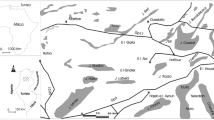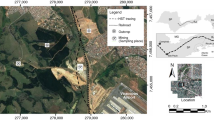Abstract
DTA techniques were employed to study the thermal and structural characteristics of hydrated aluminium oxides and aluminous clays of the Pipra pelitic rocks from district Sidhi, India. Detailed microscopic investigations, X-ray and chemical analyses reveal that these clays were derived by the localized weathering of arkosic metasediments. The chemical and normative behaviours have confirmed their formation by the isochemical metamorphism of arkose, aided by a little granitization and followed by minor retrogression. A tentative correlation between the thermal and structural changes of these oxides and clay minerals at various transition temperatures has nicely displayed the presence of kaolinite, diaspore and gibbsite. The exothermic curves of kaolinite confirm the recrystallization. The presence of kaolinite in the clay fractions indicates the detrital origin.
Résumé
Les caractéristiques thermiques et structurales des oxydes d'aluminium hydratés et des argiles des rochers pélitiques Pipra du district de Sidhi (Inde) contenant de l'aluminium ont été étudiées par ATD. Les examens au microscope et par rayons X ainsi que l'analyse chimique ont révélé que ces argiles proviennent de l'érosion localisée des métasédiments arkosiques. Les comportements chimiques et normatifs ont confirmé leur formation par métamorphisme isochimique de l'arkose, facilitée par une faible granitisation et suivie d'une retrogression mineure. Une tentative de corrélation, à diverses températures de transition, entre les changements de comportement thermique et de structure de ces oxydes et minéraux argileux a montré nettement la présence de kaolinite, de diaspore et de gibbsite. La présence de kaolinite dans les fractions d'argile indique son origine détritique.
Zusammenfassung
Die DTA wurde zur Untersuchung der thermischen und strukturellen Charakteristika hydratisierter Aluminiumoxide und aluminiumhaltiger Tonarten der Pipra Pelitfelsen aus dem Bezirk Sidhi, Indien, eingesetzt. Die eingehenden mikroskopischen Untersuchungen, die Röntgen- und chemische Analyse zeigt, daß diese Tonarten durch die lokalisierte Erosion arkositischer Metasedimente entstanden sind. Das chemische und das normative Verhalten bestätigten ihre Bildung durch isochemischen Metamorphismus von Arkose, unterstützt durch ein wenig Granitisierung und darauffolgende geringe Retrogression. Ein Versuch der Korrelation zwischen den thermischen und strukturellen Änderungen dieser Oxide und Tonmineralien bei verschiedenen Übergangstemperaturen zeigte deutlich die Anwesenheit von Kaolinit, Diaspora und Gibbsit. Die exothermen Kurven von Kaolinit bestätigen die Rekristallisierung. Die Gegenwart von Kaolinit in den Tonfraktionen weist auf ihren Gebränchs-Ursprung hin.
Резюме
Использованы методы ДТА для изучения термических и структ урных характеристик гидроокисей алюмини я и алюминиевых квасц ов в горных породах на района Сидхи в Индии. Детальн ые микроскопические исследования, рентге нографический и хими ческий анализы свидетельст вуют, что образование алюмоквасцов произо шло вследствие выветривания аркозн ых метаосадков. Их хим ическое поведение также подт верждает, что они образовались всл едствие изохимическ ого метаморфизма аркозы, протекающего с вклин иванием гранитов с последующ им незначительным ре грессом. Экспериментальная к орреляция между термическими и структурными измене ниями гидроокисей и глиноз емов с различными температ урами перехода ясно п оказала присутствие каолини та, диаспоры и гиббсйта. Эндотермич еские кривые каолини та подтвердили его рекр исталлизацию. Присут ствие каолинита в глинозем ных фракциях подтвер ждает его происхождение как сл едствие изнашивания горных п ород при трении.
Similar content being viewed by others
References
C. S. Ross andP. F. Kerre, U. S. Geol. Surv., Profess. Paper, 185 G (1934) 135.
N. R.Morgenstern and J. S.Tehalenko, Proc. Roy. Soc. London, Ser. A, 1 (1967).
J. E.Gillot, Elsevier Publishing Comp., New York, 1968.
R. M. Taylor andK. Norrish, Clay Minerals Bull. 6 (3) (1966) 127.
W. D. Keller andE. E. Pickett, J. Am. Sci., 248 (1950) 264.
V. Stubican andR. Roy, Am. Minr., 46 (1961) 32.
R. J. P. Lyon andW. M. Toddenham, Nature, 185 (1960) 835.
H. Kodama andK. Oinuma, Clays Clay Minerals, Proc. Natl. Conf. Clays Clay Minerals, 11 (1963) 236.
V. C. Farmer andJ. D. Rüssel, Spectrochim. Acta, 20 (1964) 1149.
W. E.Worrall, Maclaren and Sons, London, 1968, p. 124.
A. W. Coats andJ. P. Redfern, Analyst, 88 (1963) 906.
W. M.Wendlandt, Interscience, New York, 1964, p. 424.
L.Shapiro and W.Brannock, Contr. to Geochem., U. S. Geol. Surv. Bull., (1962) 1144-A.
A. W.Hounslow and J. M.Moore Jr., Carlton Univ. Geol. Paper, 1966, p. 66.
R. C.Mehrota, Ph. D. Thesis (unpublished), B. H. U. (1974) 66.
R. C.Mehrotra, Sem. Expl. and Expt. Mins., M. P. (1976) (In Press).
R. C. Mehrotra andS. N. Varma, Mets. Mins. Rev., 15 (4) (1976) 4.
R. C. Mehrotra andA. K. Singh, J. Sci. Res., 26 (1976) 107.
J.Zussman et al., Longmans, Green & Co. Ltd., 3 1964 p. 203.
C. E.Weaver and L. D.Pollard, Elsevier Scientific Publishing Comp., New York, 1973.
C. E. Weaver, Clays Clay Minerals, 16 (1968) 187.
E. M. Barral II andL. B. Rogers, Anal. Chem., 34 (1962) 1101.
A. Yammamoto, Bunscki Kagaku, 12 (1963) 26.
V. S. Ramchandran andS. K. Bhattacharya, J. Sci. Ind. Res., 13A, (1954) 360.
R. E.Grim, McGraw Hill Book Comp. Inc., New York, 1962, p. 405.
L. B. Sand andW. C. Ormsby, Clays Clay Minerals, Proc. Natl. Conf. Clays Clay Minerals, 2 (1954) 277.
P. De Souza Santos, H. De Souza Santos andG. W. Brindley, Am. Min., Part I, 49 (1965) 1543–1548; Part II, 50 (1965).
J.Konta, Interceram, (1969) 59–60; 102–104; 115–117.
W. D. Keller, R. F. Hanson, W. H. Huang andA. Cervantes, Clays Clay Minerals, 19 (1971) 121.
G.Millot, Springer-Verlag, New York, 1970, p. 388.
C. S. Ross andP. F. Kerr, U. S. Geol. Surv., Prof. Pap., 165-E (1931) 151.
H. W. Van der Marel, J. Int. Etud. Argiles, 1 (1958) 1.
J.Zussman et al, Longmans, Green (4) Co Ltd., 5 1964 p. 95.
Author information
Authors and Affiliations
Additional information
The authors extend their sincere thanks to Dr. S. C. D. Sah, Director, Wadia Institute of Himalayan Geology, Dehradun, for providing laboratory facilities in the Institute. They also wish to express their keen appreciation to Dr. D. K. Patwardhan, Department of Ceramic Engineering, Institute of Technology, B. H. U., and Prof. S. K. Bhattacharya, Professor Emeritus, Department of Chemistry, B. H. U., for healthy criticism and valuable suggestions. The help rendered by Mrs. Poonam in the completion of this manuscript is gratefully acknowledged.
Rights and permissions
About this article
Cite this article
Mehrotra, R.C., Varma, S.N. & Singh, B.K. Physico-chemical behaviour of hydrated aluminium oxides and associated clay minerals occurring around Pipra, district Sidhi, India. Journal of Thermal Analysis 16, 453–462 (1979). https://doi.org/10.1007/BF01910708
Received:
Revised:
Issue Date:
DOI: https://doi.org/10.1007/BF01910708




